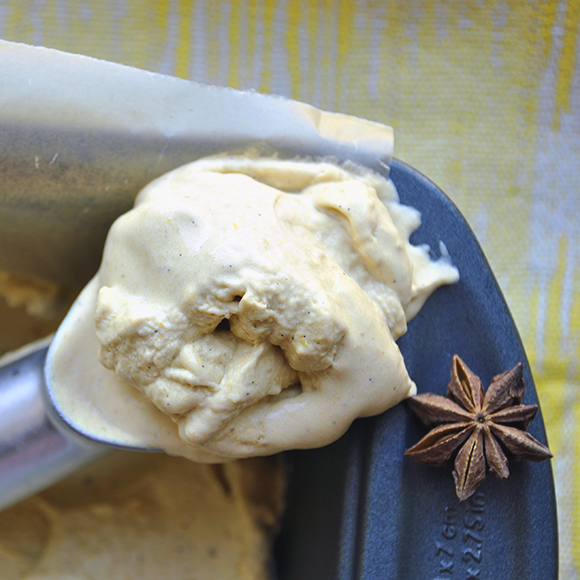
Similar to most conversations about the nutritional benefits of certain ingredients, dairy is surrounded by misinformation, and people drink the the dairy mythology by the gallons. After interviewing Krista of The Farmer’s Wifee about dairy farms, I wanted to follow up with an interview about the nutrition of dairy with Sarah Downs, a registered dietitian with Best Food Facts. After reading both Krista and Sarah’s interviews, leave a comment to share your thoughts about dairy or the Star Anise Pumpkin Ice Cream that follows the interview.
Here’s the disclosure: My recent trips to Sacramento, Arkansas and Chicago, including all expenses are sponsored by Best Food Facts, and all opinions in this series are my own. Follow the hashtag #Taste15 to read about other food bloggers and farmers participating in the same program.
About Sarah
Sarah Downs, MBA, RDN is registered dietitian with Best Food Facts and has a diverse background in nutrition ranging from food service and clinical dietetics to nutrition communications and marketing in the food industry. In her spare time, she likes to cook, explore new places (aka eat her way through different cities) and stay active!
What is pasteurized and homogenize milk?
Pasteurization was introduced more than a century ago and is an essential tool for ensuring that milk and dairy products are safe. It involves the heating of raw milk to 161.5 degrees for 15 seconds and then immediately cooling it. Pasteurization does not change the nutritional quality or taste of dairy products and protects from disease-causing microorganisms such as salmonella.
Homogenization is a process that gives milk its rich, white color and smooth texture. Milk that has not been homogenized contains a layer of cream that rises to the top of a glass. The homogenization process involves reducing the size of the fat globules into minuscule portions that are dispersed evenly throughout the milk. Homogenization usually is achieved by pumping milk through small openings under very high pressure.
What is the difference between organic and non-organic milk (or is there a difference)?
There is no significant difference in health, safety or in the nutritional content of organic milk vs conventional milk. Organic milk can occasionally contain more omega-3 fatty acids, but this amount is very small and not nutritionally significant.

For a person without major allergies to dairy, how important is dairy to our health?
Milk provides a good source of many nutrients essential for health. These nutrients include: protein, calcium, vitamin D, vitamin A, vitamin B12, riboflavin, potassium, niacin and phosphorus. The Dietary Guidelines for Americans recommends three servings of low-fat and fat-free dairy a day. If you are unable to consume any dairy due to a dairy allergy (not to be confused with lactose intolerance), you must carefully choose food substitutes. Meats, poultry, eggs, fish, nuts and legumes are all good sources of protein, but you will also need to look for dairy-free products that have been fortified with extra nutrients (vitamin D and calcium).
The Dietary Guidelines for Americans recognizes dairy foods as an important source of nutrients for those with lactose intolerance. It is important to not completely eliminate dairy from the diet, as often times they are able to tolerate small amounts of certain dairy products. This includes cottage cheese, certain types of cheese (cheddar, swiss and mozzarella) and plain Greek yogurt. There are also many types of lactose-free milk and milk products that have low or no lactose and provide the same nutrients as regular dairy foods.
A 70+ year old fan, is milk necessary for her diet? If so, why?
Again, milk provides a good source of many nutrients essential for health. These nutrient include: protein, calcium, vitamin D, vitamin A, vitamin B12, riboflavin, potassium, niacin and phosphorus. Many of these nutrients are essential for bone health and preventing bone loss as we age (which can lead to osteoporosis and unnecessary broken bones).

Is there a nutritional difference between whole and low-fat milk?
Both types of milk have nine essential nutrients, naturally occurring sodium, naturally occurring sugar (called lactase) and 8 grams of protein. The only difference is the fat and calories are higher in whole milk compared to low-fat milk. Regardless of your decision, both whole milk and low-fat milk are healthy, nutrient-dense choices. To learn more about dairy, download Wisconsin Dairy council’s PDF file, “Whole White Milk vs. Fat-Free White”
Is dairy more nutritious than non-dairy sources? If so, why?
Milk is the top food source of calcium and other important nutrients like vitamin D and potassium, which are lacking in most of our diets, plus milk contains high-quality protein. While a few milk alternatives have similar nutrient profiles to cow’s milk, many don’t have near the amount of protein or nutrients and often lots of added sugar. Be sure to check out the nutrition facts panel when looking for milk alternatives.
To learn more, visit here and here.
Lactose intolerance isn’t as common as we think. Roughly 1 in 10 adults report being lactose intolerant and that’s through self-diagnosis (which often times can be inaccurate).
A few months ago, health and scientific articles explained how gut bacteria affects our health, in which some people believe raw milk’s good bacteria is destroyed during pasteurization. Is raw better than pasteurized milk?
From a food safety perspective pasteurized milk is safer. It is extremely risky to consume raw milk. For the sake of safety, choose pasteurized milk and dairy products as an excellent source of a variety of nutrients.
To learn more about the gut and raw milk, visit “Raw Milk Q&A” at Best Food Facts.
Here’s another great article about gut microbiota and milk products by Dairy Nutrition here.
What is the difference between lactose intolerance and milk allergy?
One of the biggest misconceptions about lactose intolerance is that it is the same as a milk allergy. This is not the case at all.
With lactose intolerance you are unable to digest lactose (a sugar in milk), because you do not have enough of the enzyme lactase, which breaks down lactose. This leads to the uncomfortable GI symptoms associated with lactose intolerance.
With milk allergy your body has an immune reaction to certain milk proteins. The symptoms and treatment for the two are both different and extremely individualized. With lactose intolerance, many people can typically tolerate dairy products like yogurt and cheese, but with a milk allergy you will need to avoid all things with milk.
How common are dairy allergies? And, why is it important to visit a doctor to verify a dairy allergy before making dietary changes?
Lactose intolerance isn’t as common as we think. Roughly 1 in 10 adults report being lactose intolerant and that’s through self-diagnosis (which often times can be inaccurate).
It is important to see a doctor to be diagnosed as lactose intolerance, because self-diagnosis and elimination of all dairy can lead to nutrient shortfalls, such as lack of both calcium and vitamin D. According to the Food Allergy Research and Education, approximately 2.5% of children younger than three are allergic to milk. It’s important to note that most of these children eventually outgrow their milk allergy. If you suspect any type of food allergy, it’s extremely important to visit a doctor to receive a proper diagnosis and treatment plan. A dairy allergy can be extremely severe and even life-threatening.
What are emerging technologies being developed to make dairy better for the future?
Ultra-pasteurization: Ultra-pasteurized milk is heated to 280° F for a minimum of two seconds. This temperature and time combination is much more lethal to bacteria, killing virtually all of concern in milk. Ultra-pasteurized milk is also packaged under near sterile conditions, which makes recontamination with spoilage bacteria unlikely and rare.The average shelf-life of ultra-pasteurized milk products is 30 to 90 days when held under refrigeration, but only until the product is opened. Then it should be consumed within seven to 10 days to avoid spoilage.
Ingredients
- 1 pt. heavy whipping cream
- 3 whole star anise
- 1/2 + 1/4 cup coconut sugar
- 5 egg yolks
- 1/4 tsp. ground ginger
- 1/4 tsp. sea salt
- Pinch of freshly grated nutmeg
- 1 cup or 8 oz. of pumpkin puree
- 1 vanilla bean
Directions
- Pour cream and add star anise in a small saucepan, over medium heat. Heat cream until the edges start to simmer. DO NOT LET CREAM BOIL. Remove from heat and let cool for about 30 minutes. Tightly cover and place cream in the refrigerator overnight.
- Whisk 1/2-cup star anise cream, 1/4 cup coconut sugar, egg yolks, ginger, sea salt and nutmeg in a large bowl. Set aside.
- Pour the rest of the star anise cream (with the seeds) into a medium saucepan. Heat cream until the edges start to simmer. DO NOT LET CREAM BOIL. Turn off the heat and remove the saucepan from the stove.
- Working quickly, ladle 1/4 cup of the warm star anise cream into the egg yolk mixture. Repeat this step until there no cream is left.
- Return the egg yolk-milk mixture to the saucepan over medium heat. Constantly stir the egg yolk-cream (now called custard) mixture until it thickens to coat the back of a wooden spoon. This step should take about five to seven minutes. DO NOT LET CREAM BOIL.
- Pour custard over fine-sieve placed over a medium bowl. Use a spatula to press cream through the sieve. Return the star anise seeds to the custard.
- Gently stir in the pumpkin puree into the custard. Tightly cover and refrigerate overnight or until it’s cold.
- Remove and discard the star anise seeds and return the custard to the refrigerator.
- Prep the ice cream machine, but keep the bowl in the freezer.
- Vertically cut the vanilla bean in half. Using the back edge of a paring knife, gently and firmly slide it down the length of each the vanilla bean pod to scrape the beans. Gently stir the vanilla beans into the custard.
- Remove the bowl of the ice cream maker from the freezer, and pour the custard into the bowl.
- Follow the manufacturer’s directions for churning the ice cream.
- After about 20 to 30 minutes or when the custard is the consistency of a soft serve ice cream, pour iced custard into an ice cream container. Tightly seal or cover. Place container in the freezer to cure (or to firm) for a few hours or overnight.
- Serve and enjoy.

Learn about the pros and cons of GMOs in {Taste 15} Part I: Come with an Open Mind.
Learn about a dairy farming in {Taste 15} Part II: What’s a Dairy Farm, an interview with Krista Stauffer
I’m so grateful for this series. I think a lot of the hype around the troubles with dairy is robbing people (especially) women of an important calcium source. Thanks for running this!